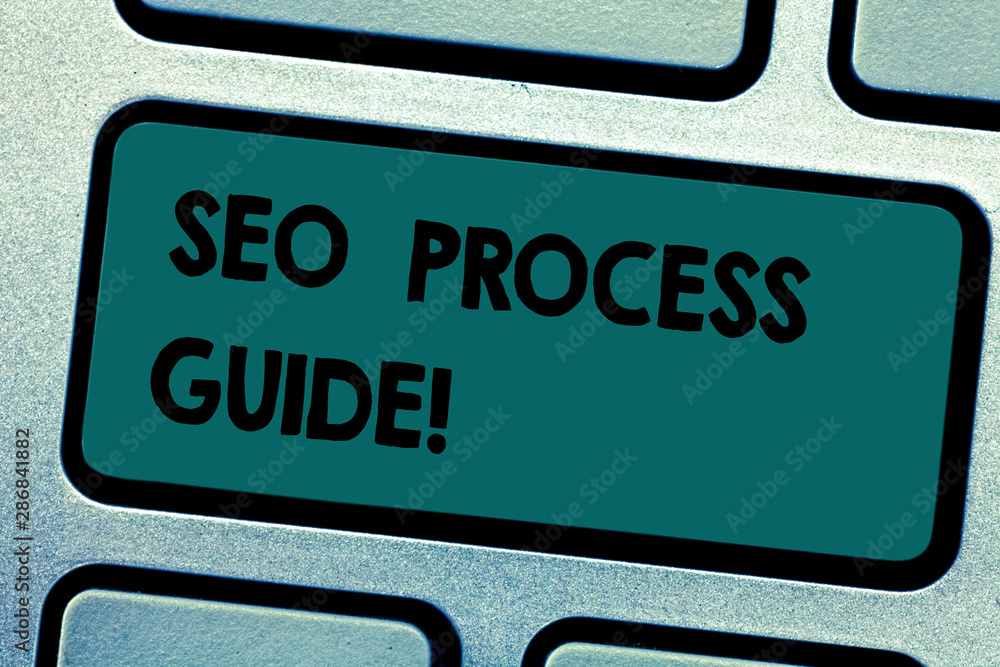
The Ultimate SEO Guide for Beginners 2023
- SEO BASIC CONCEPTS
- Keyword Research SEO Guide for Beginners
- Competitive Analysis SEO Guide for Beginners
- SEO Guide for Content Creation
- What Is SEO Content?
- Different Types of SEO Content
- Steps To Creating SEO Content
- Content Research
- Website Content Guidelines
- Website Content Optimization
- SEO Guide for Your Customers Buying Journey When Creating SEO Content
- How To Evaluate Your Competitor’s Content
- SEO Guide to Choosing the Best SEO Content Format, Design and Layout
- SEO Tools
Some of the most common questions people ask today… Business Owners- “Can I rank top on Google’s first page? Will I get massive traffic and visibility to my website with SEO? How long do I have to wait to see the SEO results?” While Content Writers ask, “Is it possible to learn SEO in one day? Is there an SEO guide for beginners in 2023?”
Well, the answer is simple! Yes, you can.
As a business owner or content writer, you can increase your website’s visibility and drive targeted traffic with SEO. You can also get higher engagement and conversions. Understanding effective SEO and its applications will help you to outrank your competitors and achieve your objectives. Here’s the ultimate SEO guide for beginners in 2023, which includes an overview of the key SEO concepts and strategies for improving your search engine rankings.
SEO BASIC CONCEPTS
What Is Search Engine Optimization (SEO)
SEO, Search engine optimization is the process of organically increasing the visibility of a website or a web page in a search engine result. SEO improves the performance of your website while accurately positioning your web pages on the search engine unpaid results. It helps to attract both existing and prospective target audiences to your business.
Here are some other SEO definitions-
Ahrefs SEO Guide: “SEO is the process of optimizing your website to rank higher in search engine results pages (SERPs) for relevant keywords.”
Moz: “Search engine optimization (SEO) is the practice of increasing the quantity and quality of traffic to your website through organic SEO techniques.”
Search Engine Land: “Search engine optimization (SEO) is the process of optimizing a website, as well as all the content on that website so that, it will appear in prominent positions in the organic results for search engines.”
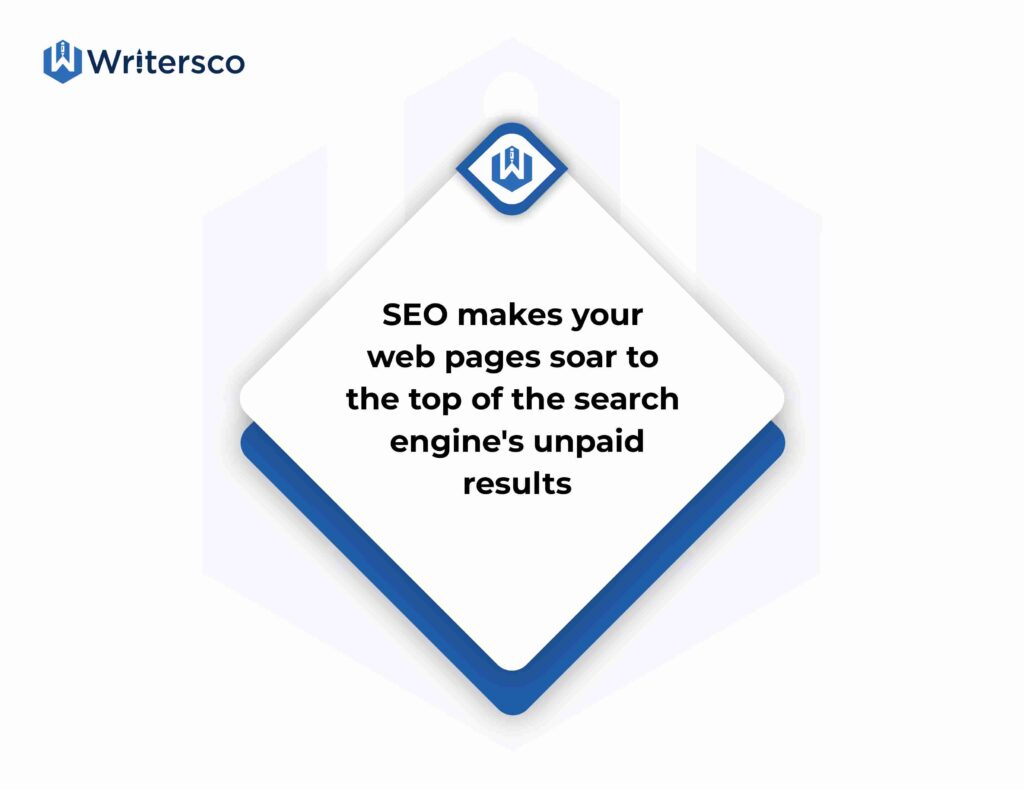
About The Search Engines
You can think of search engines like a genie in a bottle, except that instead of granting wishes, they help people find what they’re looking for on the internet. Unlike genies, search engines are always ready to help and they provide answers that match your search queries. These search engines include Google, Yahoo, Bing, DuckDuckGo, and other search engines.
For instance, Google alone processes over 3.5 billion searches per day! With this SEO guide for beginners in 2023, you can learn to optimize your website for Google. In today’s digital age, having a strong online presence is crucial for any business or individual looking to establish themselves as a thought leader in their industry. It is essential to set up your business sites to be found by these search engines.
How Do Search Engines Work
The search engine’s goal is to provide its users with useful information that matches their search query. Hence, when a user types a query into a search engine, it uses a complex algorithm to scour the internet. Then, it finds and provides the websites that are most relevant to the user’s search query.
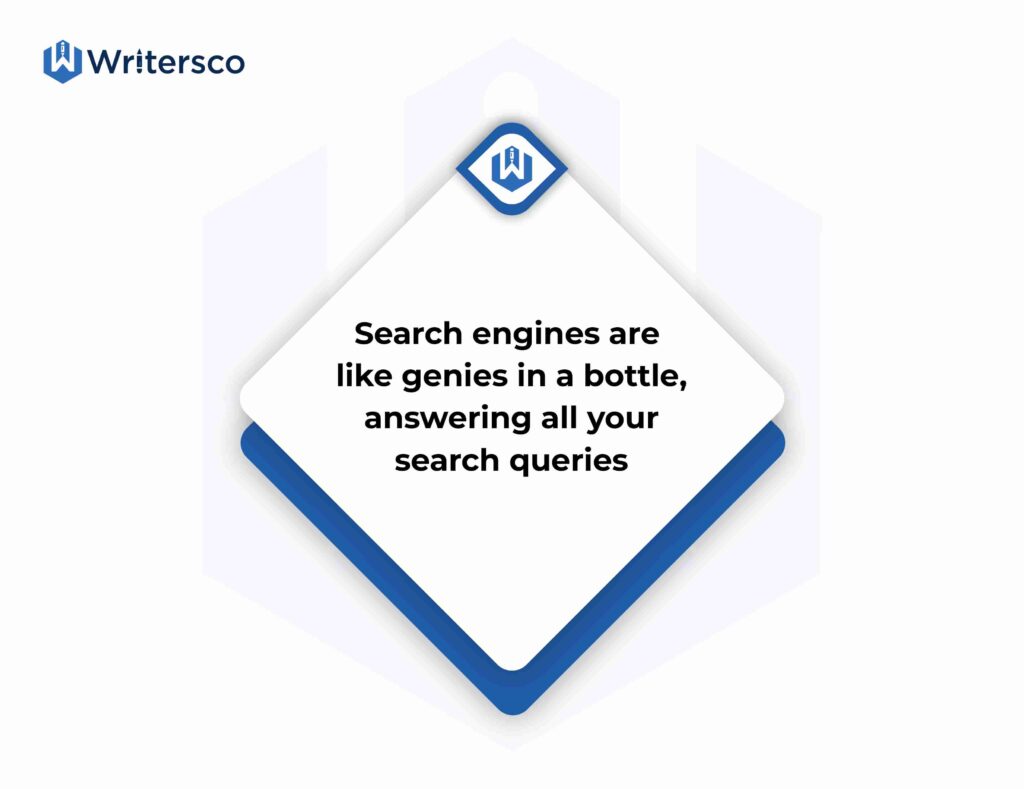
How Does the Search Engines Rank Your Content
Once the search engine has a list of relevant websites, its algorithm decides which websites should be shown first, second, or third, and it keeps listing in an ascending order. It’s like a popularity contest, but instead of being held in a high school, it’s on the internet. So, the websites that have the most votes (links) and the most valuable content with rich SEO keywords emerges top on the search engines.
Keyword Research SEO Guide for Beginners
What Is a Keyword
A keyword is usually a word or phrase that a user would type into a search engine when seeking for information or a specific service or product. For example, if a user intends to buy a new car seat for a child, they might type “best child car seats” into a search engine. The word “car seat” in this example is the keyword.
The Different Types of Keywords
As a beginner seeking an SEO guide, you need to understand that there are several types of SEO keywords. These include short-tail keywords, long-tail keywords, branded keywords, and LSI keywords.
Short-tail Keywords: This type of keywords are short phrases that are typically one or two words long. They are generally used to target a wide range of search queries as they typically cover a broader scope. For example, “SEO”, SEO Guide”, “SEO Content”, “SEO Specialist”, “SEO Service” are all short-tail keywords.
Long-tail Keywords: These keywords are longer phrases that are usually three or more words long. They are generally more specific and are used to target a smaller, more specific group of search queries. For example, “SEO services for small business” is a long-tail keyword.
LSI (Latent Semantic Indexing) Keywords: This refers to semantically related keywords. They are related words or phrases about a central keyword which the search engines use to understand the context of a piece of content. For example, “Marketing” encompasses semantically related keywords like “Marketing Promotional Mix,” “Digital marketing,” and “Content Marketing.” However, if your central keyword is “SEO,” then you can have “SEO Marketing”, “SEO Tools”, “SEO ranking”, “SEO Strategy”. These keywords help search engines understand the relationship between different words and concepts.
Branded Keywords: These are keywords that include a brand name. These keywords are used to target searches for a specific brand. For example, “Louis Vuitton Luxury” and “Google SEO” are branded keywords.
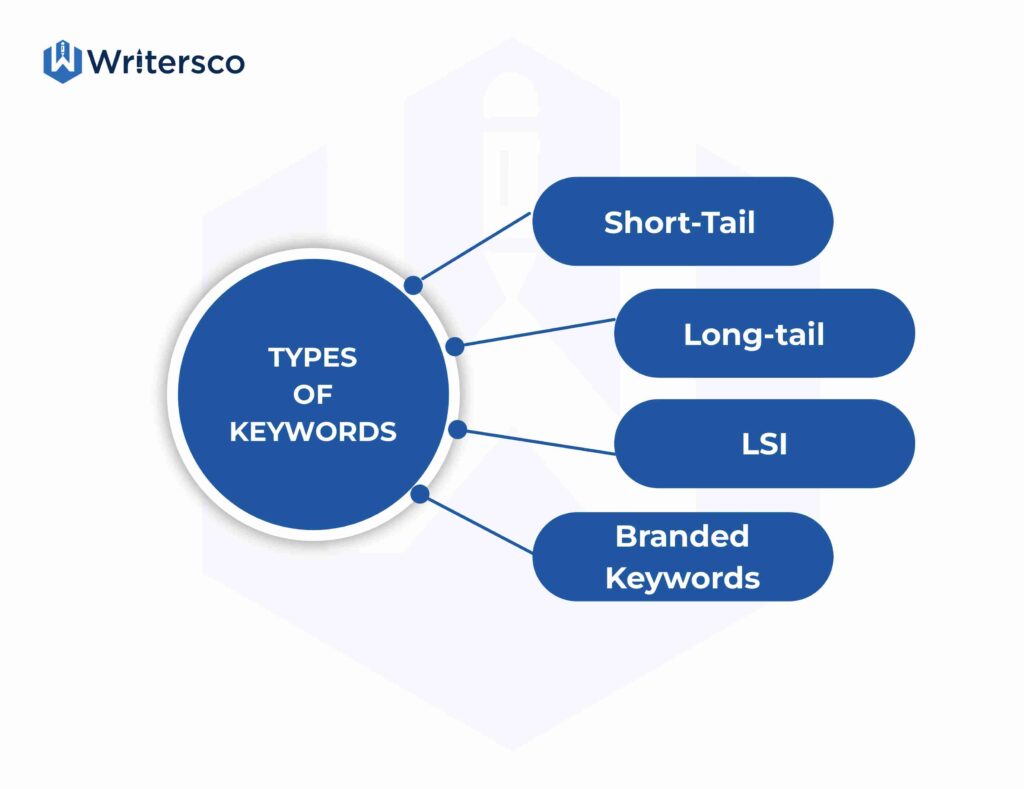
Understanding The Intent Behind a Keyword
Search intent can be broken down into four main categories: Informational, Navigational, Transactional, and Commercial Investigation.
Informational Intent: They is when a user looks for information on a specific topic. For example, if a user types “how to optimize website for SEO” into a search engine, they are most likely searching for information on how to optimize a website for SEO.
Navigational Intent: This refers to a user who is trying to find a specific website or webpage. For instance, if a user types “Instagram” into a search engine, they are likely looking for the Instagram site.
Commercial Investigation Intent: These are keywords used when a user is in the research phase of a purchase. For instance, if a user types “best SEO tools” or “top keyword research tools” into a search engine, they are likely researching the best SEO or keyword research tools available before making a purchase.
Transactional Intent: When a user is looking to purchase or take some kind of action. For example, if a user types “buy SUV car online” into a search engine, they are likely looking to purchase an SUV car online.
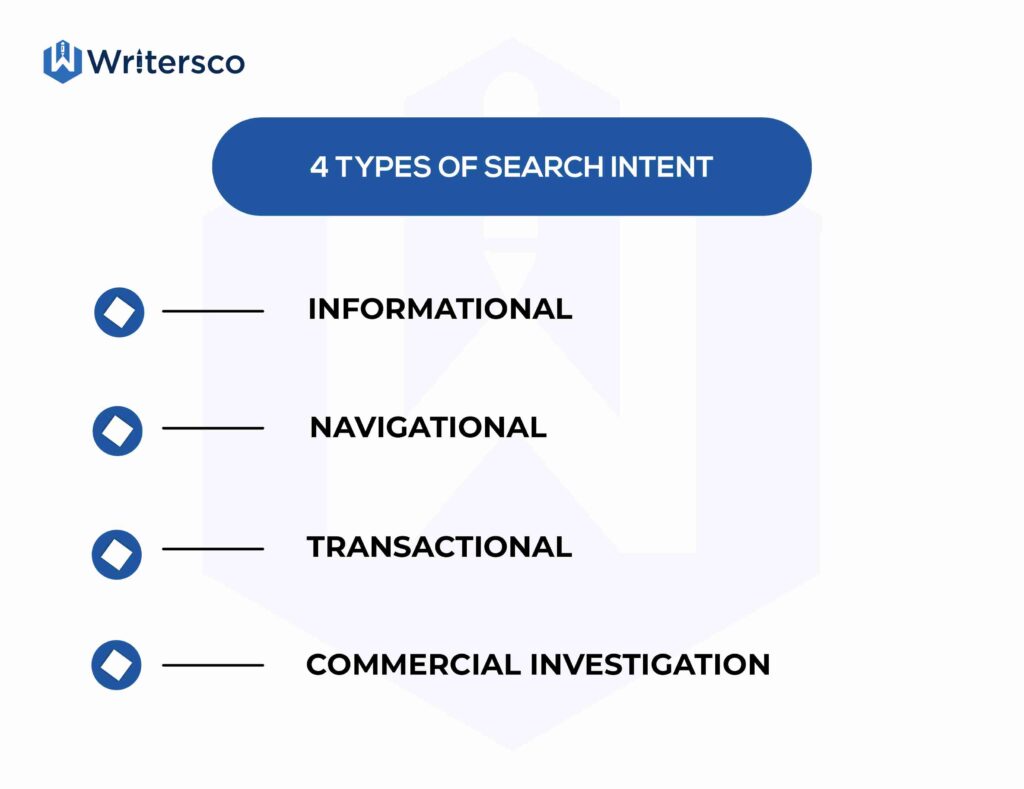
Examining The Search Query on Search Engines
As a beginner, another crucial thing to pay attention to in this SEO guide is the search queries on the search engines. Once you have gotten a list of potential keywords you want to rank for, it’s important to examine the search query on search engines. It will enable you see how competitive the keyword is and how many people are searching for that keyword. You can use tools like Google Keyword Planner, SEMrush, Ahrefs, and Moz Keyword Explorer to research keywords and see their search volume and competition.
About Keyword Research
Keyword research is the process of finding the best keywords to target for your website. It’s an important part of SEO because it helps you understand what people are searching for and how to optimize your website to rank for those keywords. By researching and targeting the right keywords, you can drive more relevant traffic to your website.
How To Find the Best Keywords to Target
The best keywords to target are those that have a high search volume and low competition (low keyword difficulty). High search volume keywords are frequently searched for by users. They mostly indicate a high level of interest in the topic which makes the keywords highly competitive. Low-competition keywords are keywords that many other websites don’t target, making it easier for your website to rank for those keywords.
Once you’ve found a list of keywords to target, it’s important to analyze the search volume and competition of each keyword to determine which ones will be the most effective for your website. Also, try to group the keywords and target them in pages or sections of your website, this will help you to optimize the content and increase the relevance of the site for those keywords.
To find the best keywords to target, you can use keyword research tools. These tools can provide valuable insights into the search volume and competition of different keywords. You can also use the following techniques to find the best keywords to target:
Analyze your competitors
Look at the keywords your competitors are targeting and consider whether they would be a good fit for your website.
Examine your own analytics
Your website’s analytics data can provide valuable insights into the keywords people are using to find your website.
Use a keyword research tool
Tools like Keyword Everywhere, Uber suggest, SEMrush, and Ahrefs, can provide valuable insights into the search volume and competition of different keywords.
Utilize the autocomplete function of search engines
Search engines like Google, Bing and Yahoo often show suggestions when you start typing in a keyword. These suggestions can give you an idea of what people are searching for.
Look at the questions people are asking
Use tools like AnswerThePublic to see the questions people are asking about a specific topic. You can also find questions with key phrases people ask on Google. These questions can give you an idea of the keywords to target.
Competitive Analysis SEO Guide for Beginners
Competitive keyword analysis is a vital part of SEO as it helps to understand what keywords your competitors are targeting in their SEO efforts. This includes researching the keywords they are ranking for, the content they are creating, and the backlinks they are building. By identifying the keywords that your competitors are targeting, you can gain valuable insights into what is working for them, and how you can improve your own SEO efforts to outrank them.
For example, if you own an online store that sells wedding dresses, and you want to outrank your competitors, you will need to know what keywords they are targeting. You can use tools like SEMrush or Ahrefs to research your competitors’ keywords, and you might see that the keyword “wedding dresses” has a search volume of over 1.5M per month, KD of 66 and a CPC (cost per click) of $1.44 (these are sample numbers, the actual data may vary).
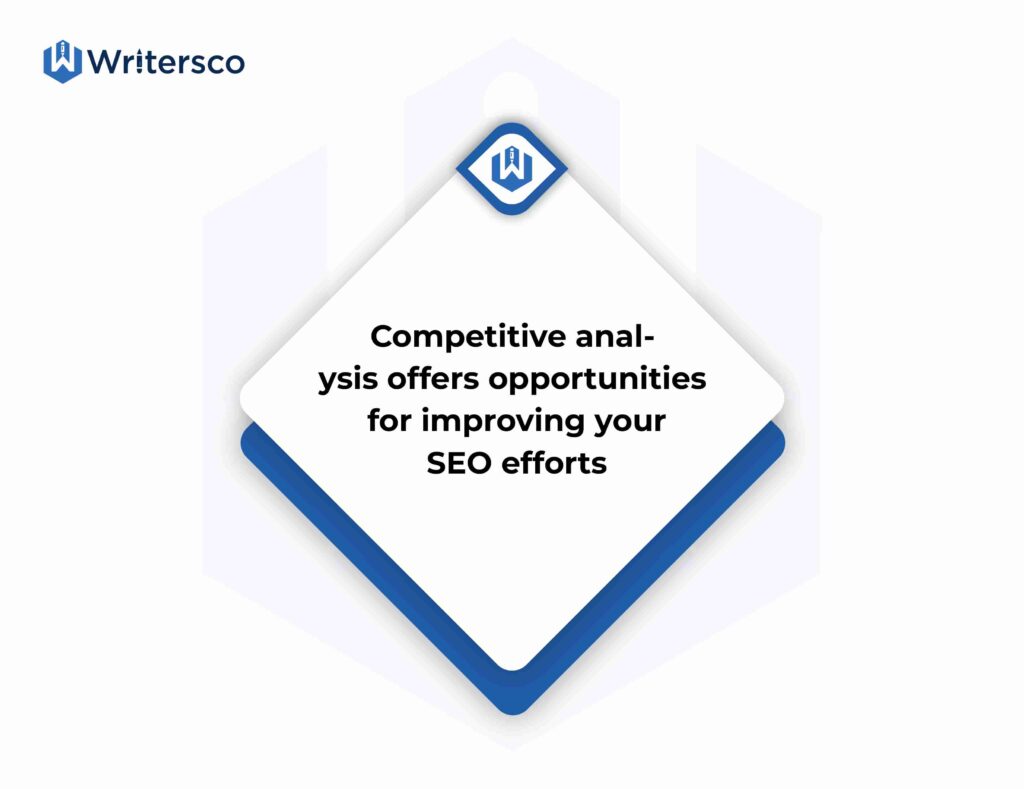
How To Identify Your Competitors
There are several SEO tactics to identify your competitors. One way is to simply enter your keywords into a search engine and see which websites appear on the first page of the search results. These are the websites that are currently outranking you. Another way is to use SEO tools such as SEMrush, Ahrefs, and Moz, which can provide you with a list of competitors based on your target keywords.
For example, if you are searching for luxury shoes on Google, you will see the top websites that are ranking for the keyword “luxury shoes” such as Chanel, Dior, and Prada. These are your competitors.
How To Discover Your Competitor Keywords
Once you have identified your competitors, the next step is to discover the keywords that they are targeting. You can do this by analyzing their website and looking at the keywords they are using in their content, meta tags, and URLs. Additionally, you can use SEO tools such as SEMrush, Ahrefs, and Moz to research your competitors’ keywords.
For instance, using SEMrush, you might find your competitor Dior is ranking for keywords such as “luxury shoes for women,” “best luxury shoes for women,” and “luxury shoes for men.”
How To Use Your Analysis for Keyword Targeting
After conducting your competitive keyword analysis, the next step is to use the information you have gathered to improve your own SEO efforts. You can use your analysis to identify new keywords to target, to optimize your existing content and meta tags, and to identify opportunities for building backlinks. Additionally, you can use this information to create a keyword strategy that will help you to outrank your competitors and drive more relevant traffic to your website.
For instance, based on your competitor analysis, you might find out that ” best luxury shoes for men” or “best luxury shoes for women” are keywords with high search volume and low competition. Then, you can target these keywords in your SEO strategy and optimize your website’s content with these keywords.
SEO Guide for Content Creation
What Is SEO Content?
SEO content is quite different from the typical article that some people write. An SEO content is a type of content that is optimized for search engines. It’s created with the goal of ranking highly in search engine results pages (SERPs) for specific keywords. This type of content is designed to help search engines understand the topic and relevance of a webpage. It is created to help users find the right information they are seek on the internet. SEO content includes text, images, videos, infographics and other forms of content that can be indexed by search engines.
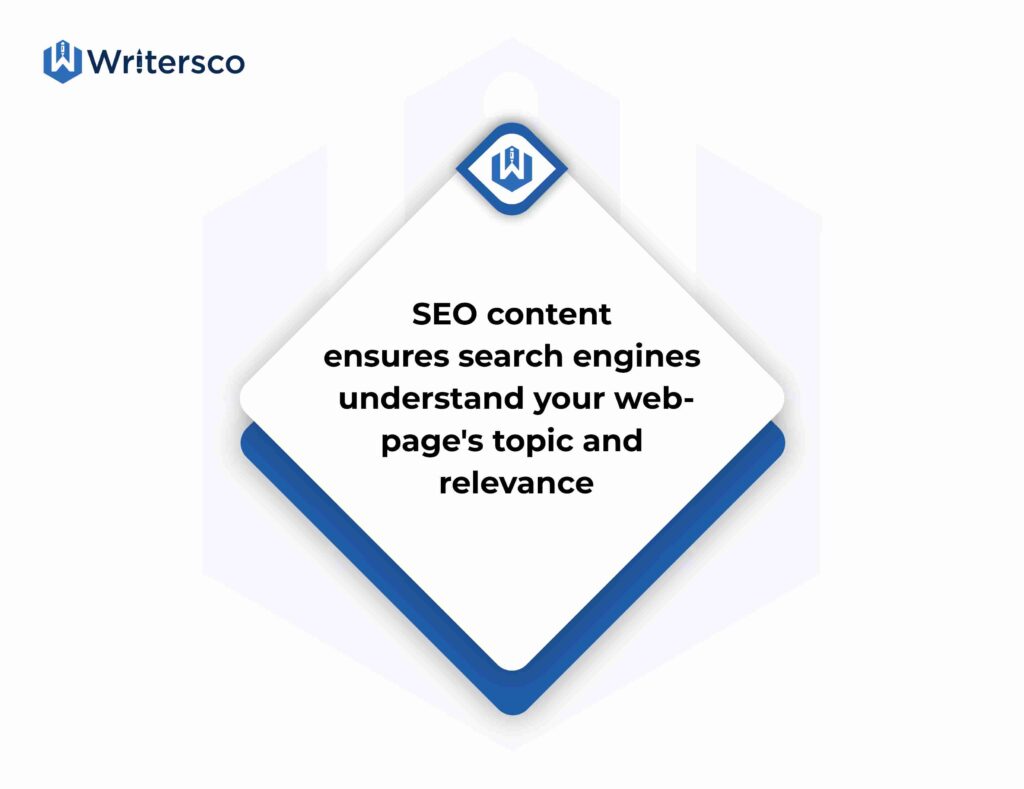
Different Types of SEO Content
There are several different types of SEO content that can be used to improve the search engine rankings of a website. These include:
Short Form Content
This type of SEO content is great for targeting long-tail keywords, which are phrases that are more specific and less competitive. It is intended to provide quick, bite-sized information on a specific topic that can help to engage and retain readers. Typically, short form SEO content are less than 1000 words and is great for social media sharing. It is created specifically for increasing brand visibility and engagement on social media and driving traffic to a website.
Long Form Content
This is typically over 1000 words and is great for increasing time spent on a website, which is a ranking factor for search engines. It provides in-depth information on a specific topic such asinformative, educational blog articles that are designed to provide value to the reader. Long form SEO contentis great for targeting a wide range of keywords and for providing fresh and relevant information. It helps to increase a website’s visibility in search engine results pages (SERPs) by providing regularly updated blog content.
Pillar Page Content
This type of webpage content is in-depth, comprehensive, and remain relevant for a long time. It drives traffic to a website over time, which can help establish a website as an authority on that topic. They can be used to target a wide range of keywords, which can help increase visibility in SERPs and drives relevant traffic to a website.
Landing Pages
These are pages that are designed to capture leads or to convert visitors into customers. They typically include a form for visitors to fill out and can be used to target specific keywords.
Product And Service Pages
These are pages that are dedicated to a specific product or service. They are designed to provide detailed information about the product or service and to convert visitors into customers.
Pictures And Videos
These are visual representations of information that are designed to be easy to understand and share. They are usually used to educate, inform or entertain the audience. They can be used to target specific keywords and to provide value to the reader.
Steps To Creating SEO Content
For a beginner who needs an SEO guide, you need to know that the steps required when creating SEO content. SEO content is a multi-step process that involves conducting research, creating content, and optimizing that content for search engines. The steps involved in creating SEO content include:
- Conducting Keyword Research: This is the process of identifying the keywords that you want to target with your content. You can use tools like SEMrush and Ahrefs to research keywords and identify those with the highest search volume and lowest competition.
- Conducting Content Research: This involves researching your industry, your target audience, and your competitors to understand what kind of content is currently trending or meeting needs, and what gaps in the market exist that your content can fill.
- Creating The Content: This is the process of actually creating the content, whether that be a blog post, product page, or infographic. The content should be high-quality and provide value to the reader while also incorporating the target keywords.
- Optimizing The Content: After you have created the content, you would need to optimize it for search engines. This includes optimizing the meta tags, such as the title tag and meta description, as well as incorporating the target keywords into the content in a natural way.
- Promoting The Content: Once the content is published, it is important to promote it to drive traffic to the website. You can do this by sharing the content on social media, building backlinks to the content, as well as directly reaching out to other websites to request that they link to the content.
Content Research
Content research is an integral step in creating SEO-friendly content. It allows you to understand what topics are currently trending in your industry. In this stage of SEO content writing, you can identify the content that has already been written as well as the existing gaps that you can fill to outrank your competitors. You can do this through a variety of methods, such as analyzing your competitors’ content that is already ranking top on the internet, reading industry blogs, and monitoring social media content in your niche. With this research in hand, you’ll be able to create content that is both valuable to users and optimized for search engines.
Website Content Guidelines
Website content guidelines are a set of rules and best practices that you can follow when creating content for a website. These guidelines help to ensure that the content is high-quality, relevant, and optimized for search engines. Some common website content guidelines include:
- Creating high-quality, informative, and engaging content
- Using target keywords in the title, URLs, meta description, and throughout the content
- Using appropriate headings and subheadings to organize the content
- Optimizing images and videos with descriptive file names and alt tags
- Optimizing the content for readability and SEO
Website Content Optimization
Website content optimization is the process of making sure that the content on a website is SEO optimized for search engines. This can include optimizing the meta tags, such as the title tag and meta description. It is also essential to optimize your pictures, infographics and videos. Ensure toadd your target keywords naturally throughout the content.
SEO Guide for Your Customers Buying Journey When Creating SEO Content
The customer buying journey refers to the stages a customer goes through when making a purchase. These stages including awareness, consideration, and decision. When creating SEO content, it is important to factor in the customer buying journey and create content that addresses the specific needs and concerns of the customer at each stage. For example, a customer in the awareness stage may be looking for general information about a product or service, while a customer in the decision stage may be looking for specific details and reviews in order to take action.
How To Evaluate Your Competitor’s Content
Evaluating your competitors’ content is an important step in creating SEO content. You can do this by analyzing their website, reading their blog posts and articles, and monitoring their social media accounts. When evaluating your competitors’ content, you should look at the topics they cover, the format of their content, and the keywords they use. This will give you an idea of what is working for your competitors and how to outrank them.
SEO Guide to Choosing the Best SEO Content Format, Design and Layout
Creating an SEO content is not an arduous task. What you need is to understand how to choose a format, design, and layout that will be most effective for your target audience and for search engines. Some popular formats include blog posts, product pages, infographics, and videos. The design and layout should be visually appealing and easy to navigate, with a clear and consistent structure. It’s also important to consider mobile optimization when choosing the format, design and layout. This is why it is recommended to optimize your website design and structure for SEO.
To determine the best format, design, and layout for your content, you can use tools like Google Search Console and Google Analytics to analyze the performance of your existing content and identify which formats are most effective. Additionally, you can look to industry experts and successful websites in your niche for inspiration and best practices.
Once you have chosen the best format, design, and layout for your content, it is important to consistently use that format across all of your content. This will help to establish a recognizable brand identity and make it easier for users and search engines to navigate your website.
SEO Tools
SEO Keyword Research Tools:
SEO Analysis Tools:
Domain Authority Checker Tools:
- Moz Domain Authority
- Ahrefs Domain Rating
- SEMrush Domain Score
- Majestic Trust Flow
- Domain Hunter Gatherer
Backlink Profile Analysis Tools:
SEO Content Writing Tools:
SEO Website Audit Tools:
SEO Reporting Tools:
Marketing SEO Tools:
SEO Software Tools:
SEO Keyword Tracking Tools:
SEO Ranking Tools:
These tools can help you track your website’s search engine ranking for specific keywords, as well as monitor the rankings of your competitors. They provide detailed data of your website’s organic search performance, including search engine rankings, backlinks, organic search traffic, and more. They also provide suggestions for improving your rankings, such as identifying and resolving technical SEO issues on your website, and optimizing your content for specific keywords.
SEO content is a vital aspect of search engine optimization. With high-quality, relevant, and optimized content, you can improve your website’s search engine rankings and drive more targeted traffic to your website. By following the SEO guide above, you can create effective SEO content that will help you to outrank your competitors and achieve your business objectives.


